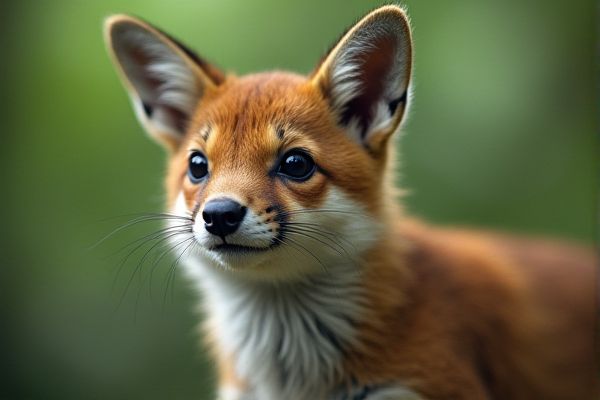
AI enhances wildlife photography by automating image recognition, making it easier to identify species and analyze wildlife behavior. Advanced algorithms can sift through thousands of images, identifying patterns and providing data on animal populations and habitats. Drones equipped with AI technology allow photographers to capture footage from unique angles while minimizing human disturbance in sensitive environments. Machine learning models also improve post-processing, enabling photographers to enhance images with precise adjustments, thereby elevating the overall quality of wildlife visuals.
AI usage in wildlife photography
Image Recognition Technology
AI usage in wildlife photography enhances the efficiency of identifying species through advanced image recognition technology. This capability allows photographers to quickly sort through large volumes of images, ensuring that they can capture rare moments with precision. For example, tools like Google's TensorFlow can categorize animals in real time, increasing the chances of documenting elusive wildlife behaviors. The integration of AI not only streamlines the workflow but also opens up opportunities for more detailed studies of animal behavior and preservation efforts.
Automated Species Identification
AI usage in wildlife photography offers the possibility of automated species identification, enhancing the efficiency of capturing and analyzing animal images. For instance, specialized algorithms can help photographers and researchers accurately classify species in their natural habitat. This technology reduces the time spent on manual identification, allowing for quicker data collection and analysis. The potential advantage lies in enabling conservationists to monitor populations and protect endangered species more effectively.
Camera Trap Automations
AI can enhance wildlife photography by automating camera trap functionalities, allowing for more efficient data collection. This technology can analyze movements and patterns, increasing the chances of capturing rare species in natural habitats. For instance, institutions like the Wildlife Conservation Society are leveraging AI to improve monitoring practices. By reducing the need for human presence, camera traps equipped with AI can minimize disturbances to wildlife, fostering better conservation efforts.
Low-Light Imaging Enhancement
AI can significantly enhance low-light imaging for wildlife photography, improving the clarity and detail of images taken during dusk or dawn. Technology like machine learning algorithms enables the reduction of noise and enhancement of brightness in images, making it easier to capture elusive animals in their natural habitats. The possibility of using AI-driven software, such as Adobe Lightroom, offers photographers the chance to elevate their work without extensive equipment upgrades. With these advancements, wildlife photographers can capture stunning visuals that may have otherwise been lost in challenging lighting conditions.
Behavior Pattern Analysis
AI can enhance wildlife photography by analyzing animal behavior patterns, offering insights into their habits and habitats. For instance, using AI algorithms, photographers can predict the best times to capture specific species, such as the elusive snow leopard. This technology enables more effective tracking and observation while minimizing disturbance to wildlife. With the chance to understand and document wildlife more accurately, photographers can contribute to conservation efforts through their work.
Real-Time Data Processing
AI in wildlife photography enhances the ability to capture rare moments through real-time data processing. For instance, cameras equipped with AI technology can automatically adjust settings based on environmental conditions, increasing the chances of obtaining high-quality images. This capability can enable photographers to focus more on composition rather than technical adjustments, potentially leading to more creative shots. Institutions like National Geographic utilize these advancements, showcasing the advantages of integrating AI into their photography practices.
Drone Deployment Optimization
AI can enhance wildlife photography by analyzing animal behavior and optimizing drone flight paths. Drones equipped with AI algorithms can effectively scout areas to locate wildlife, minimizing the disturbance to natural habitats. This technology can increase the chances of capturing rare moments while allowing photographers to maintain a safe distance. Institutions like the Wildlife Conservation Society are exploring these advancements to improve both research and conservation efforts.
Threat Detection Algorithms
AI can enhance wildlife photography by automating the detection of animals in their natural habitats. Utilizing threat detection algorithms, photographers can identify potential risks to wildlife, such as poachers or environmental changes. For example, conservation groups may implement AI tools to monitor endangered species through camera traps. This technology presents the opportunity for photographers to contribute to wildlife conservation efforts while capturing impactful images.
Habitat Mapping Techniques
AI technology offers significant advantages in wildlife photography by enhancing image recognition and processing speed. For instance, using algorithms, photographers can identify and categorize species more efficiently than traditional methods. Habitat mapping techniques can benefit from AI by analyzing vast datasets to determine wildlife distribution patterns. This synergy can lead to improved conservation efforts and a deeper understanding of ecosystems.
Poaching Surveillance Systems
AI can significantly enhance wildlife photography by improving image quality and helping in identifying species through automated analysis. For instance, using algorithms in poaching surveillance systems can help in detecting illegal activities in protected areas, thereby aiding conservation efforts. The chance of capturing rare wildlife moments increases when AI assists in optimal camera placement and timely captures. This technology can also predict animal movements, providing photographers with better opportunities to document their behaviors.
 techknowy.com
techknowy.com